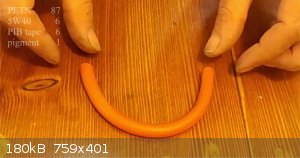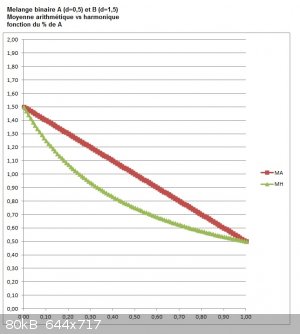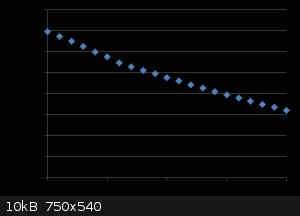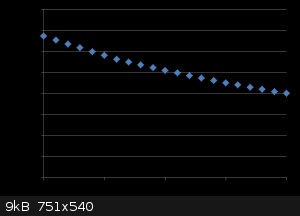| Pages:
1
2
3 |
underground
National Hazard
   
Posts: 703
Registered: 10-10-2013
Location: Europe
Member Is Offline
|
|
Markx i have already polybutene (not PIB) from bird repellant (read my above posts) but did not worked well
|
|
|
Fulmen
International Hazard
    
Posts: 1716
Registered: 24-9-2005
Member Is Offline
Mood: Bored
|
|
I haven't tried the bird repellant, but PIB from tape works fine in combination with oil even at 90% solids.
We're not banging rocks together here. We know how to put a man back together.
|
|
|
Laboratory of Liptakov
International Hazard
    
Posts: 1394
Registered: 2-9-2014
Location: Technion Haifa
Member Is Offline
Mood: old jew
|
|
Underground you need this: http://www.ebay.co.uk/itm/Toolcraft-Poly-Isobutylene-PIB-Aut...
Is it tested, working, nothing problem. No cutting. Normal 2 meter to gasoline tape as snake. No filtration. Tape can be ( is it better), as one snake
in gasoline. For all times. As dead worm. In long (30 days+) concentration increasing. PIB is pretty expensive, therefore is better let the snake in a
glass. And concentration determine again. After a long time, it is possible to pull out the whole snake from the glass. Stretch between the fingers.
Filtration is almost impossible. Dishes and destroyed everything around. All times tested. And 1:1 with oil, of course.
Liptakov.
|
|
|
VladimirLem
Hazard to Others
  
Posts: 204
Registered: 24-5-2010
Member Is Offline
Mood: Have no fear <Vlad> is here.
|
|
I think/hope so...
I think im going to try this (95%ETN, 5 vaseline)...its not some kind of plasic explosive, but should work pretty good to get a high density (but,
with alots of tests before, casue shit is pretty sensitive) without that much work
However...anyone already did ETN/Vaseline?
|
|
|
underground
National Hazard
   
Posts: 703
Registered: 10-10-2013
Location: Europe
Member Is Offline
|
|
Vladimir if you are going to try this, please tell us the results
[Edited on 26-12-2015 by underground]
|
|
|
pdb
Hazard to Self
 
Posts: 81
Registered: 8-4-2004
Member Is Offline
Mood: No Mood
|
|
Sebacate impact : none ?!
After purchasing bis(2-ethylhexyl) sebacate, I started testing around 20 combinations, with the follwing protocol :
- PETN 85% in all recipes (when/if I find a satisfactory formula, I will increase PETN percentage point by point until it becomes non usable)
- 15% built by mixing 3 ingredients : Blu-Tack binder 8-15% + sebacate 0-5% + oil SAE 10W 0-5%
My findings so far :
- oil softens the plastic but makes it sticky to fingers (same as with vaseline). Difficult to get ride of when on your skin
- Blu-Tack binder yields a moldable product, while 3M self-amalgaming tape binder gives something hard and crumbly, which does not stick to itself
- I didn't see any difference with & without sebacate, which puzzles me.
I know lots have been discussed on this forum about platicizing PETN or RDX, but nothing definitive. I would be interested to hear from someone having
experienced with sebacate.
Thanks.
|
|
|
Laboratory of Liptakov
International Hazard
    
Posts: 1394
Registered: 2-9-2014
Location: Technion Haifa
Member Is Offline
Mood: old jew
|
|
plasticizer
You watching this: https://www.youtube.com/watch?v=-Brs1bqr_7M
Only 8% - 10% plastificator is possible used for all materials. ...LL...
Conditions are using tape and oil 5W40. Usually 1:1.
|
|
|
Laboratory of Liptakov
International Hazard
    
Posts: 1394
Registered: 2-9-2014
Location: Technion Haifa
Member Is Offline
Mood: old jew
|
|
plasticizer
For this energetic material was used PETN a basically fraction 0,1 x 0,1 mm. Milled through sieve (0,1 ) as dry material. EM content (estimate) a very
fine parts, 0,01 mm cca 10% from all. Content PIB from self-amalgamating tape 6%, synthetic motor oil 5W40 same, 6%. Plasticizer together 12%. Used
watercolor - acrylate red and orange, mixed after plastification. Maybe 0,7 to 1,5 % in dry form. ...LL...

|
|
|
Laboratory of Liptakov
International Hazard
    
Posts: 1394
Registered: 2-9-2014
Location: Technion Haifa
Member Is Offline
Mood: old jew
|
|
plasticizer
New link on basic preparation plastic material. https://www.youtube.com/watch?v=euVUa7C5rAM
........LL........
Development of primarily - secondary substances CHP (2015) Lithex (2022) Brightelite (2023) Nitrocelite and KC primer (2024)
|
|
|
greenlight
National Hazard
   
Posts: 737
Registered: 3-11-2014
Member Is Offline
Mood: Energetic
|
|
That looks great LL.!
I will have to try it as a replacement for using polybutene bird repellent as the binder as it takes hours of rolling and doesn't get to that
plasticity.
Good work.
Be good, otherwise be good at it 
|
|
|
Laboratory of Liptakov
International Hazard
    
Posts: 1394
Registered: 2-9-2014
Location: Technion Haifa
Member Is Offline
Mood: old jew
|
|
Well, this tape is I mean best. Has ideal molecule weight, respectively long of molecular chains is ideal for purpose as plastic binder. Bird
repellent has short chains, (low molecular weight) therefore is difficult or impossible preparation good binder. Thanks for
watching,.......LL........
Development of primarily - secondary substances CHP (2015) Lithex (2022) Brightelite (2023) Nitrocelite and KC primer (2024)
|
|
|
greenlight
National Hazard
   
Posts: 737
Registered: 3-11-2014
Member Is Offline
Mood: Energetic
|
|
Yes, the end product looks very good.
I cannot get the bird repellent PE to pull apart and stretch like that without breaking.
One question I have is what is the final density of your plasticized explosive?
Is it as high as you can get with bird repellent like 1.4-1.45.
Be good, otherwise be good at it 
|
|
|
Laboratory of Liptakov
International Hazard
    
Posts: 1394
Registered: 2-9-2014
Location: Technion Haifa
Member Is Offline
Mood: old jew
|
|
plasticizer
Well. In video is not explosive, but only fine the flour. But with some material (1,77) can be in plastic consistence about 1,4. At handle pressing.
With ratio 8% PIB + 4% oil, can be density 1,5g /cm3. However material will has low plasticity. But for filling shaped charge is better just using
hard plastic. There can increase density on 1,6g /cm3. This method was measured. And confirmed 1,58g /cm3.......LL.........
Development of primarily - secondary substances CHP (2015) Lithex (2022) Brightelite (2023) Nitrocelite and KC primer (2024)
|
|
|
greenlight
National Hazard
   
Posts: 737
Registered: 3-11-2014
Member Is Offline
Mood: Energetic
|
|
Thats sounds good as the plastic I am using at the moment is @ density 1.45 but using about 14% inert material.
I just ordered some of the same tape and I will give it a go with the next batch as you have convinced me.
Thanks LL....
[Edited on 8-1-2017 by greenlight]
Be good, otherwise be good at it 
|
|
|
PHILOU Zrealone
International Hazard
    
Posts: 2893
Registered: 20-5-2002
Location: Brussel
Member Is Offline
Mood: Bis-diazo-dinitro-hydroquinonic
|
|
Quote: Originally posted by Laboratory of Liptakov  | Well. In video is not explosive, but only fine the flour. But with some material (1,77) can be in plastic consistence about 1,4. At handle pressing.
With ratio 8% PIB + 4% oil, can be density 1,5g /cm3. However material will has low plasticity. But for filling shaped charge is better just using
hard plastic. There can increase density on 1,6g /cm3. This method was measured. And confirmed 1,58g /cm3.......LL......... |
If I do the calculation right...
Density of PIB and oïl is 0,90 g/cm³; content 12%
Density of the explosive powder is 1,77 g/cm³; content 88%
so
Density of mix 12/88 = (0,90*12%)+(1,77*88%) = 1,6656 g/cm³
You write 1,4 --> Where does the 16% gap come from (1,4/1,6656 =0,8405)? Air?
PH Z (PHILOU Zrealone)
"Physic is all what never works; Chemistry is all what stinks and explodes!"-"Life that deadly disease, sexually transmitted."(W.Allen)
|
|
|
Dornier 335A
Hazard to Others
  
Posts: 231
Registered: 10-5-2013
Location: Northern Europe
Member Is Offline
Mood: No Mood
|
|
Almost!
The density of the mixture is not the arithmetic mean, it's the harmonic mean. Which gives
1/(0.12/0.9+0.88/1.77) = 1.59 g/cm3.
It's still 12% air by volume though - it might be suboptimal grain geometry but I have a feeling it enters while you knead the plastic (just like when
candy canes are made).
|
|
|
Laboratory of Liptakov
International Hazard
    
Posts: 1394
Registered: 2-9-2014
Location: Technion Haifa
Member Is Offline
Mood: old jew
|
|
I know, seems it that is it all unusual, according arithmetic mean should by 1.66 g /cm3. However only in machine pressing in thick metal cavity. At
normal use is all always worse. Therefore PETN 88/12 with density (in cavity shaped charge) 1,58 is very good result. And even it is almost precise,
what describe Dornier. .....LL.......
Development of primarily - secondary substances CHP (2015) Lithex (2022) Brightelite (2023) Nitrocelite and KC primer (2024)
|
|
|
PHILOU Zrealone
International Hazard
    
Posts: 2893
Registered: 20-5-2002
Location: Brussel
Member Is Offline
Mood: Bis-diazo-dinitro-hydroquinonic
|
|
Quote: Originally posted by Dornier 335A  | Almost!
The density of the mixture is not the arithmetic mean, it's the harmonic mean. Which gives
1/(0.12/0.9+0.88/1.77) = 1.59 g/cm3.
It's still 12% air by volume though - it might be suboptimal grain geometry but I have a feeling it enters while you knead the plastic (just like when
candy canes are made).
|
Wow! I didn't knew this and was wrong for so much time.
Thank you Dornier 335A, I was really missing that information...especially if working onto detonic parameters what are strongly density dependant...
The bigger the density difference between A and B into a binary mix, the bigger the effect (lower bending of the harmonic mean vs the arithmetic one).

PH Z (PHILOU Zrealone)
"Physic is all what never works; Chemistry is all what stinks and explodes!"-"Life that deadly disease, sexually transmitted."(W.Allen)
|
|
|
DubaiAmateurRocketry
National Hazard
   
Posts: 841
Registered: 10-5-2013
Location: LA, CA, USA
Member Is Offline
Mood: In research
|
|
Hmm, isnt the % of air also dependent on viscosity of the plasticizer/polymer?
|
|
|
Laboratory of Liptakov
International Hazard
    
Posts: 1394
Registered: 2-9-2014
Location: Technion Haifa
Member Is Offline
Mood: old jew
|
|
Also I am thanks for Dornier. Harmonic mean.....1/(0.12/0.9+0.88/1.77) = 1.59 g/cm3.....is a new thing, information for my. Very
interesting.......LL........
Development of primarily - secondary substances CHP (2015) Lithex (2022) Brightelite (2023) Nitrocelite and KC primer (2024)
|
|
|
Dornier 335A
Hazard to Others
  
Posts: 231
Registered: 10-5-2013
Location: Northern Europe
Member Is Offline
Mood: No Mood
|
|
To get an idea of how much the plasticizer hurts performance, I plotted calculated detonation velocity and pressure of a PETN/paraffin mix vs fraction
paraffin:
Detonation velocity:

Detonation pressure:

|
|
|
greenlight
National Hazard
   
Posts: 737
Registered: 3-11-2014
Member Is Offline
Mood: Energetic
|
|
Nice, where did you get the data from?
I use a PETN PE at the moment with 14% binder/plasticizer and I calculated the detonation velocity to be around 7000 m/s which agrees with what you
have on your VOD graph.
[Edited on 10-1-2017 by greenlight]
Be good, otherwise be good at it 
|
|
|
Fulmen
International Hazard
    
Posts: 1716
Registered: 24-9-2005
Member Is Offline
Mood: Bored
|
|
Interesting, but also misleading (I think). I assume you're using theoretical density here, and in reality that's very hard to accomplish.
We're not banging rocks together here. We know how to put a man back together.
|
|
|
PHILOU Zrealone
International Hazard
    
Posts: 2893
Registered: 20-5-2002
Location: Brussel
Member Is Offline
Mood: Bis-diazo-dinitro-hydroquinonic
|
|
Do those graphs only take into account the density variation (for example playing with Kamelet's and the simple harmonic mean of densities of paraffin
wax and PETN) or also the impact of the paraffin wax onto the oxygen balance and the overal energy output?
Can you share a little the calculations behind the plot/graph?
Funny to see that the attenuation becomes less with the increasing % wax --> at 40% must be close to 5 km/s and stil over 100 kbar...I wonder to
see extrapolation up to 100% wax...theorically should be positive VOD and pressure by extrapolation... while practically of course should be 0...
Would be nice to turn your plot from .png to .jpg sothat your plot doesn't show at first preview like a black board (this dissappear if you click on
it).
PH Z (PHILOU Zrealone)
"Physic is all what never works; Chemistry is all what stinks and explodes!"-"Life that deadly disease, sexually transmitted."(W.Allen)
|
|
|
Bert
Super Administrator
        
Posts: 2821
Registered: 12-3-2004
Member Is Offline
Mood: " I think we are all going to die. I think that love is an illusion. We are flawed, my darling".
|
|
Having seen vacuum degassing used to eliminate or at least minimize bubbles and voids when casting composite rocket fuel grains, I wonder if anyone
has tried adapting vacuum processing to plastic explosive manufacture?
Rapopart’s Rules for critical commentary:
1. Attempt to re-express your target’s position so clearly, vividly and fairly that your target says: “Thanks, I wish I’d thought of putting it
that way.”
2. List any points of agreement (especially if they are not matters of general or widespread agreement).
3. Mention anything you have learned from your target.
4. Only then are you permitted to say so much as a word of rebuttal or criticism.
Anatol Rapoport was a Russian-born American mathematical psychologist (1911-2007).
|
|
|
| Pages:
1
2
3 |